Cadillac Super Cruise Mini Review

I’ve tested Cadillac’s Super Cruise twice this year, and I had my first taste of Ford’s BlueCruise autonomous system last year.
As a journalist who covers the automotive industry, I have plenty of opinions about autonomous driving – mainly, I don’t believe we’ll see full Level 5 anytime soon. As a journalist who’s also been able to actually test AV systems, I have come to the conclusion that for now, at least, using an AV system leaves you with very mixed feelings. Especially if you’re a car enthusiast and not someone who merely uses your car as a means of conveyance.
Maybe that will change as we get more used to systems like Super Cruise, but for now, I walked away feeling a bit unnerved. Though I still think that limitations in the technology mean human drivers won’t be fully replaced anytime soon. More on that below.
To be clear, neither Super Cruise nor BlueCruise is a fully autonomous system. Let me reiterate that there is NO fully autonomous Level 5 system on the market today. The best you can get is Level 2, though some newer systems are flirting with Level 3.
Both Super Cruise and BlueCruise also only work on certain roads – roads that are mostly, if not exclusively, freeways.
This past weekend I took the Cadillac Escalade V-Series to my parent’s house for Mother’s Day. The trip is a little over 50 miles each way, with a good chunk being expressway. I’d have a chance to really test out Super Cruise – especially since my previous test, a month or two back, of the system in a CT4 was limited to a short run up and down Chicago’s famed DuSable Lake Shore Drive.
I’ll speak more about the system’s specifics when I review the V-Series, but in general, I found it to work really well, yet I was also on high alert in case the system needed me to take over at a second’s notice. I was on such high alert that it was actually more tiring than if I’d done the driving myself.
That might be a “me” problem more than a tech issue – maybe I just haven’t learned to trust this stuff yet. But I was keeping my hands near the wheel and my right foot hovering over the pedals. Even if I probably didn’t need to. That said, I did relax a bit as time went on.
Almost immediately after activating Super Cruise, which requires you to have already turned adaptive cruise control on, I encountered a traffic jam. I was ready to take over for the system but before I could I felt the Escalade slowing – and it came to a complete stop without any intervention from me. It accelerated and braked as appropriate during the stop-and-go slog. I was only tasked with taking over when a construction zone threw off the truck’s maps of the road.
Out of 110 miles or so of driving, I think about half was spent with the Escalade doing all the driving.
Super Cruise even automates lane changes. Flick the blinker, and it will change lanes for you. It will also change lanes on its own should it encounter a slowpoke that needs to be passed. This latter maneuver was a bit problematic – if the vehicle flashed an indicator of its intent in the dash, I missed it, and a couple of times I thought the system was making a mistake and manually took over when I didn’t need to.
That, again, may indicate that I am just not used to these systems enough to trust them. A prime example occurred on my return trip – road construction meant the lanes were shifted. I was in the left-most lane, and there were construction barrels between the wall and the lane, and the Escalade seemed like it wasn’t going to follow the lanes and I’d be center-punching one of said barrels. So I grabbed the wheel, flicked it, and then reset the system. Only later did I realize that the ‘Slade probably would’ve turned but it would’ve waited a split-second longer than I did. After all, the SC lights were green, indicating it was working fine. It would’ve turned red if it needed me to take over.
Of course, I may have taken more risk if the car was mine – I didn’t want to wreck an expensive Escalade that I don’t own because I put too much faith in Super Cruise. Imagine explaining that one: “Yeah I saw the barrels and the lane shift, but I’m testing Super Cruise and needed to see if it worked.”
I experienced a similar situation a few miles down the road – a crash had shut the left lane and brought out some fire trucks. As the cars in front of me shifted lanes to the right, Super Cruise kept the Escalade pointed straight, and it even started to accelerate to the set cruise speed when the lane cleared. I don’t know if the system didn’t “see” the fire trucks or was confused by the flashing lights. I don’t know if the truck would’ve slowed and changed lanes when it got closer to the fire trucks. I didn’t risk finding out the hard way – I took over and manually maneuvered it around the scene.
Again, was that a lack of trust on my part or a system failure? I don’t know and didn’t want to find out. Once again, imagine explaining that one – in this case, to the first responders: “I saw you and the lights, but I really needed to see if Super Cruise would navigate around you. For the sake of journalism.”
Super Cruise does monitor you, the driver, to make sure your eyes are on the road and you’re ready to take over. I found its monitoring to be inconsistent – one time, a quick glance at a billboard was enough to get the system to alert me to get my eyes back on the road. Another time, a longer look off to the side didn’t trigger anything and the Caddy trundled along blissfully under Super Cruise’s control.
I’ll close this with one final note – you become extra aware of drivers who cut you off when you’re hovering over the controls, ready to take over. Fortunately, the system always seemed to adjust to some asshole squeezing into a too-tight gap and either slowed the ‘Slade and/or changed lanes.
I don’t know how much I’d rely on Super Cruise or BlueCruise if I owned a vehicle so equipped. I did, after a while, start relaxing and trusting the system more. I wouldn’t recommend playing with your phone or becoming otherwise distracted – it’s still not safe, and things can happen fast at 70 mph – but I can see why someone would be tempted. Especially once you start to feel comfortable with the system.
I am not yet convinced you’ll be giving up your driver’s license and buying a car that can drive you everywhere anytime soon. We’ve seen too many issues with Tesla’s misleadingly named Full-Self Driving system, and Super Cruise and BlueCruise remain limited to certain roads. Those latter two systems also still occasionally get flummoxed – or at least seem to react more slowly than I feel comfortable with.
But autonomous driving will be a larger part of your driving experience going forward, especially if you have luxury car money. I’d recommend keeping perspective – it can be a useful tool that makes freeway driving a little easier, but never forget that you’re in charge and must be ready to take over.
Or just get yourself a 20-year-old Miata and do all the driving yourself. That might be the cure for any AV-induced confusion.
[Images: Cadillac]
Become a TTAC insider. Get the latest news, features, TTAC takes, and everything else that gets to the truth about cars first by subscribing to our newsletter.

Tim Healey grew up around the auto-parts business and has always had a love for cars — his parents joke his first word was “‘Vette”. Despite this, he wanted to pursue a career in sports writing but he ended up falling semi-accidentally into the automotive-journalism industry, first at Consumer Guide Automotive and later at Web2Carz.com. He also worked as an industry analyst at Mintel Group and freelanced for About.com, CarFax, Vehix.com, High Gear Media, Torque News, FutureCar.com, Cars.com, among others, and of course Vertical Scope sites such as AutoGuide.com, Off-Road.com, and HybridCars.com. He’s an urbanite and as such, doesn’t need a daily driver, but if he had one, it would be compact, sporty, and have a manual transmission.
More by Tim Healey
Latest Car Reviews
Read moreLatest Product Reviews
Read moreRecent Comments
- Bouzouki Cadillac (aka GM!!) made so many mistakes over the past 40 years, right up to today, one could make a MBA course of it. Others have alluded to them, there is not enough room for me to recite them in a flowing, cohesive manner.Cadillac today is literally a tarted-up Chevrolet. They are nice cars, and the "aura" of the Cadillac name still works on several (mostly female) consumers who are not car enthusiasts.The CT4 and CT5 offer superlative ride and handling, and even performance--but, it is wrapped in sheet metal that (at least I think) looks awful, with (still) sub-par interiors. They are niche cars. They are the last gasp of the Alpha platform--which I have been told by people close to it, was meant to be a Pontiac "BMW 3-series". The bankruptcy killed Pontiac, but the Alpha had been mostly engineered, so it was "Cadillac-ized" with the new "edgy" CTS styling.Most Cadillacs sold are crossovers. The most profitable "Cadillac" is the Escalade (note that GM never jack up the name on THAT!).The question posed here is rather irrelevant. NO ONE has "a blank check", because GM (any company or corporation) does not have bottomless resources.Better styling, and superlative "performance" (by that, I mean being among the best in noise, harshness, handling, performance, reliablity, quality) would cost a lot of money.Post-bankruptcy GM actually tried. No one here mentioned GM's effort to do just that: the "Omega" platform, aka CT6.The (horribly misnamed) CT6 was actually a credible Mercedes/Lexus competitor. I'm sure it cost GM a fortune to develop (the platform was unique, not shared with any other car. The top-of-the-line ORIGINAL Blackwing V8 was also unique, expensive, and ultimately...very few were sold. All of this is a LOT of money).I used to know the sales numbers, and my sense was the CT6 sold about HALF the units GM projected. More importantly, it sold about half to two thirds the volume of the S-Class (which cost a lot more in 201x)Many of your fixed cost are predicated on volume. One way to improve your business case (if the right people want to get the Green Light) is to inflate your projected volumes. This lowers the unit cost for seats, mufflers, control arms, etc, and makes the vehicle more profitable--on paper.Suppliers tool up to make the number of parts the carmaker projects. However, if the volume is less than expected, the automaker has to make up the difference.So, unfortunately, not only was the CT6 an expensive car to build, but Cadillac's weak "brand equity" limited how much GM could charge (and these were still pricey cars in 2016-18, a "base" car was ).Other than the name, the "Omega" could have marked the starting point for Cadillac to once again be the standard of the world. Other than the awful name (Fleetwood, Elegante, Paramount, even ParAMOUR would be better), and offering the basest car with a FOUR cylinder turbo on the base car (incredibly moronic!), it was very good car and a CREDIBLE Mercedes S-Class/Lexus LS400 alternative. While I cannot know if the novel aluminum body was worth the cost (very expensive and complex to build), the bragging rights were legit--a LARGE car that was lighter, but had good body rigidity. No surprise, the interior was not the best, but the gap with the big boys was as close as GM has done in the luxury sphere.Mary Barra decided that profits today and tomorrow were more important than gambling on profits in 2025 and later. Having sunk a TON of money, and even done a mid-cycle enhancement, complete with the new Blackwing engine (which copied BMW with the twin turbos nestled in the "V"!), in fall 2018 GM announced it was discontinuing the car, and closing the assembly plant it was built in. (And so you know, building different platforms on the same line is very challenging and considerably less efficient in terms of capital and labor costs than the same platform, or better yet, the same model).So now, GM is anticipating that, as the car market "goes electric" (if you can call it that--more like the Federal Government and EU and even China PUSHING electric cars), they can make electric Cadillacs that are "prestige". The Cadillac Celestique is the opening salvo--$340,000. We will see how it works out.
- Lynn Joiner Lynn JoinerJust put 2,000 miles on a Chevy Malibu rental from Budget, touring around AZ, UT, CO for a month. Ran fine, no problems at all, little 1.7L 4-cylinder just sipped fuel, and the trunk held our large suitcases easily. Yeah, I hated looking up at all the huge FWD trucks blowing by, but the Malibu easily kept up on the 80 mph Interstate in Utah. I expect a new one would be about a third the cost of the big guys. It won't tow your horse trailer, but it'll get you to the store. Why kill it?
- Lynn Joiner Just put 2,000 miles on a Chevy Malibu rental from Budget, touring around AZ, UT, CO for a month. Ran fine, no problems at all, little 1.7L 4-cylinder just sipped fuel, and the trunk held our large suitcases easily. Yeah, I hated looking up at all the huge FWD trucks blowing by, but the Malibu easily kept up on the 80 mph Interstate in Utah. I expect a new one would be about a third the cost of the big guys. It won't tow your horse trailer, but it'll get you to the store. Why kill it?
- Ollicat I am only speaking from my own perspective so no need to bash me if you disagree. I already know half or more of you will disagree with me. But I think the traditional upscale Cadillac buyer has traditionally been more conservative in their political position. My suggestion is to make Cadillac separate from GM and make them into a COMPANY, not just cars. And made the company different from all other car companies by promoting conservative causes and messaging. They need to build up a whole aura about the company and appeal to a large group of people that are really kind of sick of the left and sending their money that direction. But yes, I also agree about many of your suggestions above about the cars too. No EVs. But at this point, what has Cadillac got to lose by separating from GM completely and appealing to people with money who want to show everyone that they aren't buying the leftist Kook-Aid.
- Jkross22 Cadillac's brand is damaged for the mass market. Why would someone pay top dollar for what they know is a tarted up Chevy? That's how non-car people see this.



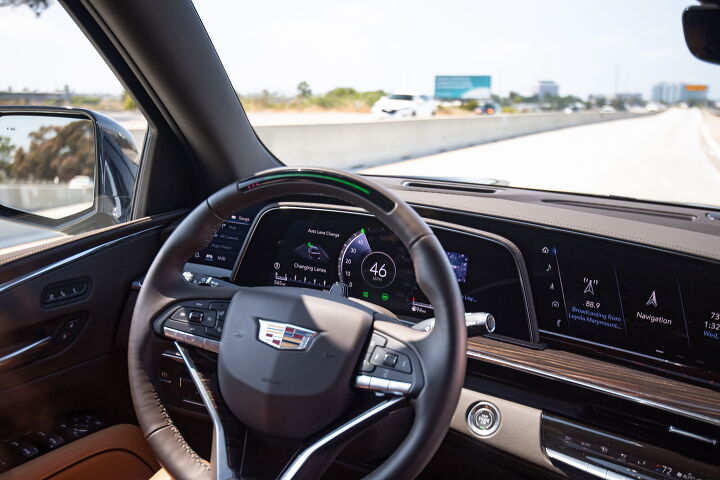

















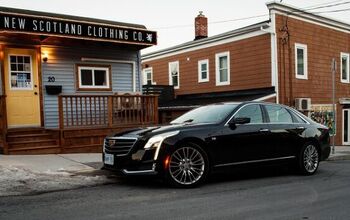
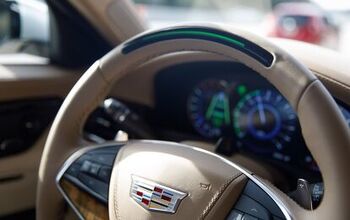

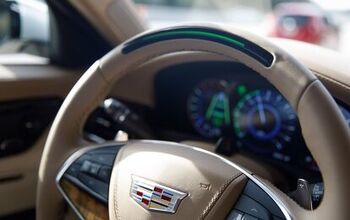
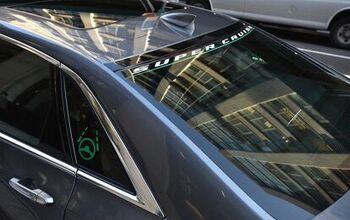










Comments
Join the conversation
@Tim Healey - Why assume that the Escalade would have shifted over for the barrels? After all, if the light was green, it might indicate it was aware of the lane shift ... or it might indicate that it was blissfully unaware of the lane shift and really would have plowed right into a barrel.
I think your problem is that you know too much. If you were a perpetually distracted driver, you would welcome this system, because it would enable your bad, careless - even reckless behavior. So, as with many things in life, the people who use it the most are the ones who are least qualified to have it. (Alcohol, drugs, guns, power, you name it...)
First picture: "Man, this Super Cruise makes me sleepy... so sleepy... oh crap, I forgot to shave AGAIN!"